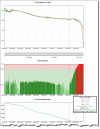Hello everyone, new member here, and I'm very glad I found this forum!
I want to start by giving some context on myself as a flier. I've been flying my
Mavic 2 Pro for about a year, and I've never really had any safety issues. I have a recreational drone license and I read the manuals carefully. I'm a fairly frequent flier and I've logged many hours of flying since I've gotten the drone.
Fast forward to today, I was out by a mountainside, somewhat high up (~7000ft elevation) but definitely within the working bounds of the drone, and trying to film a video of the afternoon sun above the clouds. I launched my drone by a roadside, well clear of any vehicles and pedestrians, and started filming my video. 2 minutes later, I lost downlink with the drone, possibly because there was some trees blocking the radio signals. At that point, my controller indicated that it had switched to "Return to Home" mode, which I expected it to do so since in the few times that I've had connections issues with my drone, my drone automatically switched to Return-to-Home and came back successfully. However, I waited for 5 minutes and still the connection had not been restored, so I drove a little further, to an area I believed would no longer be blocked by said trees, and reestablished connection with my drone. However, to my horror, the drone, during the 5 minutes of disconnection, had flown almost a kilometer away and was definitely not heading back towards the original launch site. What was even more troubling was the controller and the DJI GO 4 app were both showing the drone was in Return-to-Home mode. So, I tried to switch to manual control in order to manually fly it back, but quickly realized the drone was not responding to my inputs---despite being on full throttle, it would not move in the direction of my controls. At this moment, the low battery warning began to flash so I decided to just let the drone handle Return-to-Home like it always does when it's on low battery, but again, it failed to fly towards its starting point. Instead, it drifted away from me, decreasing in altitude, and eventually, when the battery ran out, it appears to have crashed. During its last minutes, the low battery warning automatically trigged it to land-in-place, which made it descend along the side of the mountain, The last transmission I received showed it being ~750 feet below my starting altitude. Unfortunately, the crash site is nowhere close to the road and the trek down the mountainside seemed too dangerous, so I wasn't able to retrieve the drone.
I've uploaded my flight record to AirData and the shareable link is here:
(you can download the original txt file from it). I've also uploaded my DAT files to a Google Drive folder
here. If any of you are able to help me understand why my drone flew away, that'd be greatly appreciated!
A final question: when I bought the drone, I also purchased DJI Care Refresh alongside it (for precisely incidents like today), and the 1-year term on it hasn't yet expired. Since I can't retrieve the drone, I'm unsure if my DJI Care Refresh would cover this incident. Does anyone have any advice on what I can do? Is there still a way to somehow use DJI Care Refresh to get a replacement? It'd really suck if this becomes $2k down the drain...










